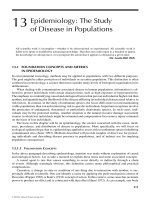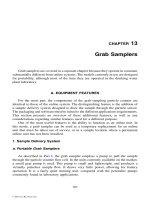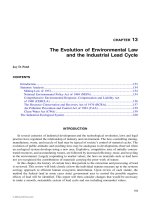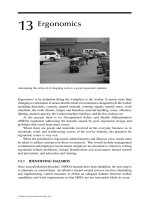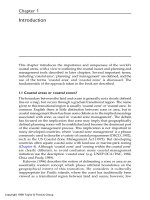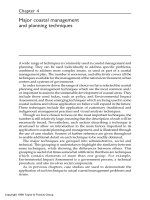GIS for Coastal Zone Management - Chapter 13 pptx
Bạn đang xem bản rút gọn của tài liệu. Xem và tải ngay bản đầy đủ của tài liệu tại đây (349.73 KB, 15 trang )
CHAPTER THIRTEEN
The Use of GIS to Enhance
Communications of Cultural and
Natural Resources and Contamination
John A. Lindsay, Thomas J. Simon,
Aquilina D. Lestenkof, and Phillip A. Zavadil
13.1 INTRODUCTION
Five Pribilof Islands, volcanic in origin and remotely located in the Bering Sea, are
home to Aleuts and the breeding grounds to 70% of the world’s northern fur seal
population and numerous seabird species. The once uninhabited islands were first
occupied by the Russians in 1786 and later became controlled by the U.S.
Government. At the time of the Russian incursions into the Aleutian Islands, some
have estimated the Aleut population at 15,000-18,000. First Russia and then the
U.S. relied on the forced labour of Aleuts relocated to the Pribilof Islands from the
Aleutian Islands chain to harvest sea otters, fur seals, and arctic fox. From their
first arrival and through much of the 20
th
century, Unangan (people) or Pribilof
Aleut people relied on the islands’ and Bering Sea’s natural resources, including
fur seals, sea lions, whales, arctic fox, walrus, sea bird species, and a variety of
plants for customary traditional purposes and subsistence. Even today natural
resources are vital to the survival interests of
Unangan on the Pribilofs. Unangan
of St. Paul and St. George Islands are the world’s single largest ethnic Aleut
community whose world population approximates 3,200 individuals. Fur seal,
endangered Steller sea lion, introduced reindeer, halibut, crab and other marine
invertebrate species, and plants, such as crowberry, continue to play a significant
role in customary traditional practices, economic development, and the
maintenance of cultural and ecological harmony.
Settlement terms under the Alaska Native Claims Settlement Act (ANCSA)
of 1971 required the National Oceanic and Atmospheric Administration (NOAA),
as the most recent of the former federal land managing agencies for these islands,
to transfer more than 95% of the land area to the local Aleuts. A 1976
Memorandum of Understanding and a 1984 Transfer of Property Agreement
(TOPA) incorporated the details of the property transfer between NOAA and
various local entities. The settlement and subsequent legislations including the
Pribilof Islands Environmental Restoration Act of 1995 and the Pribilof Islands
Transition Act of 2000 required NOAA to restore the islands’ environmental
© 2005 by CRC Press LLC
integrity compromised by U.S. Government activities supporting its commercial
fur sealing enterprise. Environmental concerns included numerous releases of
petroleum fuel products associated with the disposal of used oil, overfilling of
storage tanks, corrosion of storage tanks, pipelines, and barrels, as well as landfills
for household wastes, construction and demolition debris, scrap metal and junked
vehicles, boats, barges, and aircraft. In addition, military activities during World
War II contributed to soil and groundwater contamination. More than ninety sites
on the two inhabited islands, St. George and St. Paul, required evaluation and
potential restoration in order to complete the land transfer. The islands’
remoteness, approximately 2,200 statute miles from NOAA’s base of operations in
Seattle, Washington requires a minimum of eight hours in travel time. Weather
extremes involving fog, snow, and wind frequently cause flight cancellation.
Improving communications through such multimedia technologies as Internet,
GIS, and video were identified early as absolutely critical to the restoration
project’s success.
In the context of public land transfer to private sector entities and the
restoration of lands and structures located within a National Historic Landmark
and District, the National Historic Preservation Act (NHPA) further mandates
NOAA to mitigate for these actions. Mitigation efforts at a minimum will provide
a historical legacy associated with the federal ownership period for the benefit of
future generations. The legacy is expected to include a book, video
documentaries, and a detailed Geographic Information Systems (GIS) project. This
chapter focuses on the GIS project. The NOAA Pribilof Islands Environmental
Restoration Project Office (PPO) entered into collaboration with the St. Paul
Tribal Government’s Ecosystem Conservation Office to build a GIS project that
included not only extant conditions, but also traditional cultural and natural
resource features. This chapter presents an ongoing project that began in 1999, the
conclusion of which is not expected for several more years.
13.2 GIS APPLICATION
The environmental restoration project began nearly two decades ago. Numerous
written reports included site locations and analytical results from hundreds of soil
samples. Unfortunately, site boundaries and sample point locations have not been
easy to recover because of poor referencing and a relatively monotonous
environment that becomes overgrown with waist high vegetation or eroded by
violent winds. A decision was made at the outset to map all features using
differential global positioning systems (DGPS) and a GIS. This approach would
allow the relocation of sites and sampling points in years distant if necessary, as
well as aid in other efforts, such as defining the vertical and horizontal extent of
contamination, and the calculation of volumes of soils requiring excavation. The
PPO also recognized the importance of mapping historical, natural, and cultural
resource features, such as gravesites, to aid the communities in their future
management of the islands, and subsequently to comply with the NHPA and the
Coastal Zone Management Act.
Alaska’s high latitudes and the islands’ remoteness challenge GIS
application. Normally available geo-referenced base maps, such as topographic
quadrangles and nautical navigation charts, are scarce, small scale, or nonexistent.
© 2005 by CRC Press LLC
Early project acquisition and prosecution of DGPS data acquired with Trimble Pro
XRS and corrected with post processing layered over existing electronic versions
of nautical charts revealed positional errors requiring exhaustive research to
rectify.
Figure 13.1 Errors in previous mapping projects.
The project resurveyed the two principal islands, St. Paul and St. George, to
first order following National Geodetic Survey protocols. The results revealed a
transcriptional error in an earlier version of the cartographic process that translated
into an approximate 180-meter error (Figure 13.1). New benchmarks were
installed on the islands, and NOAA/NOS issued new nautical navigation charts in
March 2001. The chart scale, however, was still too small (1:50,000) for practical
use. The NOAA project entered into a cost share collaboration with the US
Geological Survey to provide Digital Elevation Models (DEMs) at 1:24,000 scale,
topographic quadrangles at 1:25,000 scale with 10-meter contour intervals, and
Digital Ortho Quarter Quads (DOQQ’s) at 1:12,000 scale using pre-existing
(1993) colour aerial photography. In an effort to acquire recent high-resolution
imagery, NOAA contracted with a satellite vendor to provide 1-meter
panchromatic and 4-meter multi-spectral imagery. The PPO is considering the
application of interferometric synthetic aperture radar (IFSAR) imagery of the
islands for use in establishing hydrographic controls to further improve island
charting and to monitor long-term Aeolian erosion processes that have a potential
to impact current restoration efforts. These products, when combined with
historical maps and project data, will provide a comprehensive view of the islands
and their changes over time.
© 2005 by CRC Press LLC
The Pribilof Islands GIS mapping project uses ESRI’s ArcView version 3.2.
Federal Geographic Data Committee compliant metadata allows rapid data
searches. The project focuses on several coverages and features (Table 13.1). As
noted above, base maps include NOAA navigational charts as well as airphoto-
and satellite-derived DEMs. Historical maps acquired from various sources
including libraries and published reports dating back to the late 1800’s provide a
reference for changes occurring over more than a century. Changes of interest
include fur seal, sea lion, and walrus rookery and haul out locations, as well as
building and off-road trail locations. The maps are scanned at 1200 dpi and
overlaid on registered and rectified base maps. The PPO uses Trimble Total
Station RTK (real time kinematic) 5700 DGPS survey equipment to provide real
time horizontal spatial accuracy of ±1 cm and vertical accuracy of ±2 cm.
Acquired data is used for contouring and creation of 3-D models of landfill
activities, excavations, contaminated soil stockpile volumes, and potentially for
plotting seabird nests on cliff faces combined with laser spotting technology.
Table 13.1 Pribilof Islands GIS coverages and features
Coverage Features
Geographic Islands and land masses
Geologic Soils, stratigraphy
Chemical Soil and water
Demographic
Buildings, roads, debris sites; historic and current
video and still images
Topographic
Cinder cones, landfill relief, DGPS ground
surveys, aerial and satellite imagery
Biological
(fauna and flora)
Fauna, flora, rookeries, haul outs, migration
patterns, historic and current video and still images
Oceanographic Bathymetry, currents, ice pack
Archaeological
Habitations, burial sites, historic and current video
and still images
The authors’ previous experience with marine GIS projects (e.g. Lindsay
et
al.,
1999; Butman and Lindsay, 2000) revealed the robustness of ArcView GIS.
Using hotlinks the GIS project is enabled to include multimedia features, such as
still, raster (laser line scan), and video imagery and sound recordings. The PPO
uses Canon XL-1 digital and Panasonic 720p High Definition (HD) electronic
media cameras and digital still cameras to document field activities. HD is down-
converted to standard definition. Standard Def and digital videotape
postproduction relies on MacIntosh G4 editing suites with Final Cut Pro software
and DVD Studio Pro authoring software. Real GIS data are imported into a
Hewlett Packard X4000 with XSI animation software to create textured, lighted,
and animated production quality 3D models for viewer friendly but scientifically
accurate renditions of real data. Historical video on Betacam and VHS tapes are
converted to digital format using the same hardware and software. The GIS
project itself and video mini-documentaries are placed onto DVD (digital video
disk) using super drives. (Please note that any use of trade, product, or firm names
is for descriptive purposes only and does not imply endorsement by the U.S.
Government.)
© 2005 by CRC Press LLC
13.3 ENVIRONMENTAL RESTORATION
The U.S. Government initiated environmental restoration activities on the Pribilof
Islands in 1983 following the final decision to transfer island lands from the public
to the private sector. Former operations managers, residents, and historical reports
aided in the identification of contaminant and debris sites. From a mapping
perspective the primary emphasis of the environmental restoration activities on the
Pribilof Islands has been on the locations of land features, boundaries, and the
acquisition of soil and water chemical contaminants data. Demographic land
feature focus has been on ownership, including federal land tracts and parcels
targeted for transfer under the ANSCA and TOPA, topography, cultural uses
associated with waste disposal practices, debris and contaminated waste site
boundaries, building locations, utility locations (water, electrical, fuel transfer,
cable, telephone and television lines), and grave site locations. Pribilof Islands’
soil and groundwater chemistry has typically been evaluated at sites where spills or
releases of petroleum products were suspected or known to have occurred, such as
landfills and building sites.
A significant commercial infrastructure was built on St. George and St. Paul
Islands to harvest and cure northern fur seal skins between 1872 and 1984.
Numerous buildings were constructed for brine and salt curing, barrel making,
skin packing, and seal by-product production, such as oil and animal meal. Other
structures included electrical generation plants, gasoline stations, a radio station,
fuel storage and transfer, commercial store, storage and utility buildings, a school,
health clinic, quarries, and roads. As the value of the harvesting grew, so did the
sophistication of the infrastructure and the use of petroleum based fuels for
electrical generation and motorized vehicles. Storage tanks of various sizes
ranging from about 500 gallons to 200,000 gallons and fuel lines serviced the
islands’ energy needs. Until about 1970, these tanks were filled from 55-gallon
barrels brought ashore by bidarrahs, a native rowing craft with Russian influenced
origins that were covered by sea-lion skins, and eventually by fuel barges with
floating transfer lines.
Environmental restoration efforts prior to 1999 lacked either resolve and/or
management experienced in restoration; consequently their efforts resulted in
restoration of readily visible debris that included six thousand tons of surface
debris, thousands of barrels either empty or containing used oil, and some
underground storage tanks. Contaminated soils, groundwater, and landfills were
left virtually untouched. In addition, initial efforts relied on conventional
surveying and mapping techniques that archived features on paper maps without
providing adequate geo-references. Subsequent field activities failed to recover
site boundaries and soil sampling points. Short field seasons punctuated by years
of inactivity resulted in as many as four characterizations at some sites in this
treeless and knee-high grass environment in part due to the lack of geo-referencing
and unique visual cues such as building foundations, stressed vegetation, soil
staining, or surface debris. In an effort to capture these data, the PPO scanned
existing paper maps, periodic air photos dating back to 1948, geo-referencing
these when possible, and including them in the GIS project along with textual and
tabular information. Since 1999, the PPO has relied on DGPS survey systems to
log data points and vectors, to catalogue site features, and to relocate sites and
sampling points. For the first time Pribilof Islands data was entered into a GIS
© 2005 by CRC Press LLC
project that permitted near real-time project map creation and distribution. Maps
were spontaneously created in the field office for planning and discussion
purposes. Subsequent maps demonstrated the extent of soil and groundwater
contamination, and served to increase the efficiencies of removal action decisions.
For example, diesel fuel contaminated sites are first verified by laboratory
soil chemical analyses. Using GIS created maps depicting analytical results, and
site historical and current features as guides, a removal or excavation is initiated
within the bounds defined about these analytical results. These analyses seldom
define within several meters the horizontal and vertical extent of contamination.
Therefore, following initial excavation of contaminated soils, the project relies on
thin layer chromatography (TLC) soil screening to verify whether remaining soils
have diesel fuel contamination. The project has determined that field applied TLC
based on standards offers a high probability (>95%) of accuracy within a sliding
scale (e.g. 0-100 mg/kg, 100-250 mg/kg). TLC samples and their horizontal and
vertical positions can be collected, processed, and the results entered into a GIS
within approximately two hours. The sample results are overlaid onto registered
and rectified historical air photo(s) depicting the historical structures, such as
buildings, fuel tanks and fuel lines linked as sources of the contamination but long
since dismantled. The composite photomap allows the cleanup team to substantiate
the TLC results in context with the extent of the excavation and likely sources. If
the map depicts a sample result with likely low levels of contamination, and no
historical source was within close proximity to the spot, the cleanup team has
received greater certainty about stopping further excavation. When excavation is
considered complete, additional soil samples are taken for fixed laboratory
analysis. The photomaps created during these field exercises can be displayed on
laptop computer screens, printed on photographic papers, projected onto walls and
plasma screens, and transmitted via Internet to far off locations.
High resolution (sub-meter scale) topographic maps of quarries and mineral
stockpiles are created with the DGPS and GIS. On the islands, the project is
required to purchase sand, scoria, and rock for use as backfill in excavations of
contaminated soils, making haul-roads over the tundra, and capping landfills.
Owners of the mineral rights require the purchaser to conduct pre- and post-
surveys of the quarries to first approve and then verify quantities removed to
establish a cost or royalty. The projects survey grade GPS in combination with the
GIS are used to create the survey maps.
As mentioned above, the driving force behind the environmental restoration
is the land transfer from the American government to local entities. These lands in
the form of lots, parcels, and tracts were initially surveyed more than two decades
ago using traditional surveying techniques by a separate federal agency. The
available plats are in paper form and they are not easily applied in discussions
involving numerous individuals and multiple issues that may involve structures,
and contamination of soil and groundwater. In addition some shoreline changes
have occurred since the original surveys. The project scanned and registered best
fits of these plats and entered them into the GIS project for use as overlays with air
and satellite photos. These enhanced maps from the original plats, hotlinked to
still or video imagery, greatly improved communications between on- and off-
island officials.
© 2005 by CRC Press LLC
13.4 NATURAL RESOURCE NAMING CONVENTIONS
On and around the Pribilof Islands, marine mammals and seabirds dominate the
environment. Only three terrestrial mammals are indigenous to the Pribilofs; they
include the arctic fox, the black-footed lemming on St. George, and the Pribilof
shrew on St. Paul. While English naming is the predominant convention followed
today, some
Unangan elders still refer to various species and/or their life stages in
either
Unangam tunuu (our people’s language) or Aleut language, or Russian. For
example, the arctic fox is called
aygagux in Unangam tunuu. Fur seals are
identified by sex and life stage in one or more languages. GIS mapping features
can incorporate the various naming conventions applied to these species as
appropriate.
13.5 LOCATION NAMES
Present Pribilof Islands location names are also a mixture of
Unangam tunuu,
Russian, and English. For example on St. Paul Island, Lukanin Bay and beach,
also spelled Lukannon, was named after the
promyshlenik [fur hunter] who along
with another, Kaiekov, killed 5000 sea otters during the first year of occupation in
that area. Zolotoi Beach is literally interpreted as “Golden Sands” (Martin, 1960).
Other present-day place names demonstrate American influence. On St. Paul,
Hutchinson Hill acquired its name after Hayward Hutchinson, the first American
to secure the commercial rights to the islands’ fur seals.
The northern fur seal is the most intensively studied mammal on the islands.
Records and maps of rookery locations, and haul out areas date back to the
Russian period. Henry W. Elliot and others (
cf. Elliot, 1881; Townsend, 1896;
Osgood
et al., 1915) provided some of the earliest American rookery and haul out
area maps. Rookery names as with other points of interest varied over time. For
example, today’s Northeast Point rookery on St. Paul was known during the
Russian period as Novastoshnah Rookery while in
Unangam tunuu it is Chaxax.
During NOAA’s restoration activities the Aleut community expressed desire
for greater recognition for their contribution to the islands’ history. Although the
literature is not devoid of
Unangam tunuu place names, such names are
uncommon on maps. Leaders on both islands had already begun to ascribe
Unangam tunuu (Aleut place names) but official maps were wanting. NOAA
enlisted the assistance of the U.S. Geological Survey (USGS) to procure digital
aerial mosaics of the islands for the construction of base maps and the first large
scale (1:25,000) topographic relief maps of the islands. These maps were released
as a publication in March 2003. NOAA and USGS encouraged the local residents
to document
Unangam tunuu on these topographic maps and the USGS worked to
secure their official status by having the place names reviewed and accepted as
Geographic Names by the Alaska Historical Commission.
13.6 POPULATION DISTRIBUTIONS
While the Russian discoverers, beginning with the navigator Captain Gerassim
Pribylov, may have recorded various marine mammal population statistics,
© 2005 by CRC Press LLC
locating such records will require more concerted efforts than we have so far
undertaken. But early American records clearly indicate that many of the
aforementioned species at least once flourished on the islands.
Pack ice is said to influence the comings and goings of a variety of species,
but most notably, walrus, arctic fox, and polar bear. Mastodon bones and molars
have been recovered from lava tubes on the islands, suggesting either arrival
via
land bridge or pack ice. Purportedly in 1835, long lasting pack ice around St. Paul
prevented haul out by pregnant fur seals, which resulted in the loss of both females
and potential pups (Martin 1960). The pack ice in the early 1960’s is reported by
locals to have brought a polar bear to St. Paul, as well as several other times in the
past. During 2000, pack ice was responsible for the occurrence of 6 to 7 arctic
foxes on Walrus Island, a significant seabird rookery. These foxes are largely
responsible for depopulating sea bird colonies, especially murres, on this small
rocky island. Presently, NOAA has pack ice distributions in GIS format dating
back to 1972. Ice pack incursions about the Pribilofs are being included in the GIS
Project. More detailed information can be obtained through a weblink to NOAA’s
National Environment Satellite Data and Information Service’s National Ice
Center (www.natice.noaa.gov).
As noted elsewhere, fur seals received the attention of both the Russians and
the Americans. Official duties of government agencies from both countries
included mapping rookeries and haul out areas and maintaining various population
statistics. With the passage of time, the influence of humans and the alteration of
habitat has resulted in rookeries being modified or lost. For example, Webster’s
Point and the Salt Lagoon Rookeries are no more. GIS layering of historical areas
is useful for the study of such changes, and the project also takes into account
location names as ascribed over time within and between cultures.
Figure 13.2 1948 aerial survey of Walrus Island.
The NOAA National Marine Mammal Lab has accumulated numerous aerial
photographs of seal rookeries on St. Paul. The PPO scanned, registered, and
rectified images from 1948, 1967, and the 1980’s and included them in the GIS
project.
Elliott noted (1875) only “a few sea-lions” bred on Walrus Island, although
thousands could be seen among the fur seals at Northeast Point on St. Paul.
Osgood
et al. (1915) reported only two breeding rookeries: one of these was at Sea
Lion Neck on St. Paul and the other near Garden Cove on St. George. But they
also noted major haul out areas on all five Pribilof Islands. An aerial survey in
1948 found 1,258 adult sea lions on Walrus Island, but the resolution was
© 2005 by CRC Press LLC
insufficient to determine the number of pups if any. The aerial photos have been
registered and rectified for inclusion into the GIS project. During a rare visit to
Walrus Island in 2000, our contingent observed 109 sea lions of which 11 were
pups. During the same period fewer than 10 sea lions were observed on Otter
Island. Today, despite the significantly reduced numbers, Walrus Island is the
major sea lion rookery in the Pribilofs. Eleven species of seabirds nest on the
Pribilof Islands. The red-legged kittiwake, as one example, occurs only in the
Bering Sea and it has major rookeries on the Pribilofs. Only one shore bird, the
rock sandpiper, breeds on the Pribilofs. The U.S. Fish & Wildlife Service
monitors seabird nesting on the islands, but no electronic maps are available to
date.
13.7 CULTURE AND SUBSISTENCE
Veltre and Veltre (1981) undertook the first focused comprehensive evaluation of
the subsistence natural resources on the Pribilofs, although much of their work was
acquired from historical documents dating back to the 1800’s. They point out that
the sealing industry “had significant ramifications on subsistence in the Pribilofs.”
Table 13.3 provides a listing of some representative natural resources on or about
the Pribilof Islands and the customary traditional uses of each.
Two species have been virtually eliminated from the Pribilof Islands, the
Pacific walrus and the sea otter. Neither animal apparently played much of a
subsistence role on the Pribilof Islands in part because of their demise by the
promyshleniks who sought the valuable ivory and pelts, respectively. Their
historical haul out areas are included in the GIS project.
A third species, the Steller sea lion, is close to extinction on the Pribilof
Islands as discussed above. Scans of historical maps depicting sea lion rookeries
and haul out areas are layered onto the GIS project and verified observations of sea
lions on shore will be logged into the project. Today, the sub-adult male sea lion
constitutes a subsistence resource and is hunted primarily from the shore. Some
hunting does occur on the water at St. George Island, however. Sea lion are
hunted for their meat, blubber, internal organs, and fore flipper, although in earlier
years the animal provided several customary traditional uses (Table 13.2).
Historically, the dried flesh and hides of sea lions along with fur seals has long
been a staple on the Pribilofs. The sea lion provided essential meat and clothing,
as well as covering for the bidarrah.
The northern fur seal continues to play a major subsistence role on the
Pribilof Islands with several hundred being killed on St. Paul and St. George each
year. Until recently, the U.S. Government allowed a subsistence take of 2,500
young bachelor males to be harvested each year. Today, the Tribal Governments
on each island and the NOAA National Marine Fisheries Service (NMFS) are co-
managing the subsistence harvest of fur seal. Locations authorized for subsistence
sealing by year and favourite hunting areas are being included in the GIS project.
Several recent seal midden locations are being mapped as well.
Links from the GIS maps are used to display more detailed information on
the food subsistence value offered by the northern fur seal. A link from the map to
a photograph (Scheffer 1948) that laid out the various body parts provides even
more detailed information (Figure 13.3).
© 2005 by CRC Press LLC
Table 13. 2 Species list using either Aleut or English name found on or about the Pribilof Islands and
their customary traditional use.
Subsistence Resource Customary Traditional Use
qawax Hides: baidarkas and bidarrahs (skin boats)
Intestines: waterproof garments
Throats: boot tops
Fore-flipper palms: boot soles
Stomachs: oil containers
Whiskers: traded to Chinese
Sinews from back: “thread” for sewing
Gall bladder: healing sores
Carcass, liver, lungs, lard: food (Elliott, 1881)
itxayan Carcass: food
aygagux Skin: sold for it fur value
kagayax Eggs: food
Carcass: food
chuchiigix Carcass: food
sikiita Skins and feathers: parkas
Eggs: food
Carcass: food
saquudax Plant stem: food
qayux Berries: food
Salmonberry Berries: food
aguganax Roe: food
waygix Body: food
Today, as in the past, many seabirds have customary traditional uses.
Millions of seabirds flock to the islands each year for breeding. Henry W. Elliott
was the first American on the Pribilof Islands that accounted for their natural
history and cultural subsistence through prolific writings extending over 20 years.
He noted that large flocks of
chuchiigix (Aethia pusilla) arrived in the spring and
were harvested by
Unangan with hand scoop nets. Chuchiigix, known as the least
auklet, make nests in crevices among boulders.
Chuchiigix are still hunted today
by using a long bamboo pole to strike the small birds out of the sky (bamboo often
washes up on the shores of the islands). Veltre and Veltre (1981) point out that
this is one of the few species that can be hunted by children. Elliott (1881)
reported that least auklets were replaced in late July by large flocks of red-legged
turnstones that were also eaten by
Unangan. Unlike the chuchiigix, the turnstones
bred elsewhere, but they stopped on the Pribilofs to feed on the “flesh flies and
their eggs, which swarm over the killing grounds.” The killing grounds are not
© 2005 by CRC Press LLC
nearly as extensive as they once were, but whether the abundance of turnstones on
the islands was affected is not known.
Figure 13.3 Example of hyperlinked media accessible from within the GIS: body parts and subsistence
values of a northern fur seal.
Egg gathering was a major annual activity on the Pribilofs, although it is
much less so now. Primary egg gathering areas included the steep rocky bluffs
and the tabletop flat Walrus Island. According to Elliott, the primary egg-
gathering season on Walrus Island was June-July (Elliott 1875). Historical egg
gathering locations are included in the GIS project.
The Pribilof Islands are treeless, except for a low-to-the-ground-willow
species. Several plant species afforded both cultural and subsistence value. For
example, Elliot (1875) commented that only two berry plants,
Empetrum nigrum
and
Rubus chamemorus, are readily harvested by the Aleuts during the end of
August and first week in September. These species are still much sought after and
often families spend summer afternoons harvesting the berries.
Saquudax (wild
celery) seemed to have had more importance in the past than it does now. A silent
1930’s black and white film archived in the Oregon Historical Society shows
Aleut children harvesting
saquudax and demonstrating how it is eaten. A digitized
version can be viewed via a hotlink when the distribution plots for the plant are
active in the GIS project.
Heretofore, little documentation logged by the U.S. Government, Aleut
community, or Russian Orthodox Church is known to exist as to the burial of
deceased islanders. Some gravesites are marked, while many are known only
© 2005 by CRC Press LLC
orally and most are not recalled at all. As a community service and as part of the
interest in historical documentation, NOAA received permission from the local
churches to develop a GIS project of the cemeteries. Using a survey grade GPS,
more than 700 gravesites on St. Paul and St. George Islands were entered into the
GIS project. Digital images of each location along with individual statistics
(individual names and photo, birth and death dates, and short biographical
sketches as available) are linked to the geographic locations. Printed hard copy
maps were provided for use by the local churches and municipalities. Using DVD
authoring software, the GIS project enhanced with animation and Aleut choir
music was transcribed onto a DVD. NOAA provided the respective DVDs to the
local church councils. In turn, the St. Paul Island council is relying on the Tribal
Government for long-term maintenance of the GIS project. Recently, the Russian
Orthodox Church Diocese of Alaska began promoting this GIS application
throughout the Diocese.
13.8 LONG TERM NATURAL RESOURCE MANAGEMENT
Currently, Tribal Government of St. Paul’s Ecosystem Conservation Office (ECO)
is using GIS in combination with traditional ecological knowledge for use in
environmental and resource management. Due to the increased human interactions
with the Pribilofs’ Bering Sea environment, the need to monitor and record these
interactions and their impacts on St. Paul and neighbouring islands has become
vital. Monitoring of commercial and customary traditional activities, the island
ecosystem (i.e
. numerous plant and animal species, lands, and environmental
changes), in addition to ecological disaster prevention planning are essential in
safeguarding customary traditional practices and for protecting and conserving the
health of the islands. Critical response planning to prepare the community to
effect immediate responses to future ecological perturbations is also vital as
competition increases between traditional and commercial interests for the
dwindling Bering Sea fishery resources.
The impacts associated with regional oil spills, off-road all terrain vehicle
trailbreaking, and commercial fishing along with knowledge about decreasing
populations of northern fur seals, Steller sea lions, and various seabird species
serve to highlight a need for a balanced harmony between the subsistence users
and other interests. Harmonious relations can be achieved through
communication, planning, negotiation, and mutual work towards an understanding
and respect for differences among groups. To this end, ECO has worked on
ongoing development of
Tanalix Amgignax (Island Sentinel/Guard) Program in
coordination with the Pribilof Islands Stewardship Program, PPO, NMFS, and
USFWS. This program includes the following elements:
x Promote “caretaking” and stewardship of the Pribilof Islands’ many life
systems.
x Provide a central forum that actively deals with environmental issues.
x Monitor activities that have potential adverse implications on this area of
the Bering Sea environment.
x Promote a proactive position on behalf of all life systems indigenous to
the Pribilof Islands Bering Sea area for immediate monitoring.
© 2005 by CRC Press LLC
x Exercise the Aleuts’ inherent right to be responsible for the islands’
environment.
x Share caretakership concerns and activities with others, expecting visitors
to be on their “best behavior” while visiting St. Paul Island and the
surrounding sea.
x Promote environmental and cultural awareness.
Some specific
Tanalix Amgignax activities that also involve GIS include:
preventing rats from coming to the island by actively setting and maintaining rat
traps in and around the harbour area and sanitary landfill; monitoring the islands’
shoreline and interior for natural process impacts (weather and wildlife) and
disturbances, such as vegetative changes by overgrazing reindeer, shoreline
erosion, and derelict fishing gear (i.e. nets, buoys, line, etc.) that wash up on shore;
removal of fishing gear from around fur seals’ necks; and sharing the importance
of taking care of the Bering Sea environment with the community and visitors
alike. Rat trapping locations are entered into the GIS project. If and when any rats
are captured this information will be similarly logged into the project. GIS
mapping of derelict fishing gear not only provides information to managers for
directing shoreline cleaning up efforts, but also documents the periodicity of
cleanup efforts along shorelines, the relative quantities and types of debris
recovered, and identifies areas where oceanographic conditions work to focus
debris.
Tanalix Amgignax Program is a prime example of the use of GIS in bringing
together traditional ecological knowledge and “western science.” NOAA’s
contribution to the ECO GIS project will foster the dialogue among the many
interests that the
Tanalix Amgignax Program seeks to bring together.
13.9 CONCLUSIONS
GIS application in the Pribilof Island Environmental Restoration Project afforded
insights and opportunities not contemplated at the outset of the project. The use of
DGPS technology to simply map contaminated and debris site locations, and
sampling points led to numerous significant contributions. One of the more routine
contributions involved using JPEG and TIFF files cut from the GIS project to
make maps for documents on topics such as site investigations, corrective action
plans, corrective action reports, and requests to oversight regulators for no further
action. Among other significant contributions came new nautical charts with
improved near-shore confidence by local fishers in GPS navigation systems; map
overlays of historical northern fur seal and sea lion rookeries for comparison with
current and ever changing population and environmental conditions; estimates of
shoreline erosion rates; improved control management of shoreline marine debris;
near real time mapping of contaminant excavations allowing for on the ground
decisions; sub-meter scale topographic maps to assist engineers in landfill closeout
design and calculating royalty payments from sand and scoria (used as excavation
backfill and capping solid wastes) mining; improved communications among
officials who lacked on-island experience yet hold responsibility for land transfers
following cleanup; and sorting through conflicting boundary descriptions arising
from a variety of official documents over an approximate 25-year period.
© 2005 by CRC Press LLC
A collaborative spirit between the government and Aleut entities grew out of
training opportunities provided by NOAA in DGPS and GIS, access to NOAA
DGPS equipment for ECO Projects, and contributions of GIS software to the City
of St. Paul and ECO. Subsequent collaborative geo-spatial projects further
improved overall communications. DGPS and GIS enabled local Aleuts to express
their own cultural heritage by applying Aleut location names to the first ever large-
scale topographic quadrangles of the islands. In terms of community relations, the
most significant contribution afforded by DGPS and GIS came from the mapping
of the islands’ gravesites. Unwittingly, this single DGPS/GIS exercise offered up
as a community service in context with a federal mandate to preserve historical
information provided the strongest bond and trust between the islands’ Aleut
population and U.S. Government agents.
Acquisition of precision geo-spatial data in real time is one of many
challenges in the higher latitudes. Geodetic control points, such as those offered
by Continuously Operating Reference Stations (CORS), are far and few between
in America. Alternatively, one can, as done in this project, survey in a base station
to provide short-range control. For long-term applications base stations must be
maintained against vandalism, climatic events, and curious animals such as foxes
that chew through cables. Repeater stations serve to overcome multipath
interference such as caused by hilly terrain and buildings. Once these obstacles are
overcome, real-time DGPS in combination with GIS provide the investigator with
tremendous power to work multiple field situations near real time as well as
providing for long-term documentation.
13.10 REFERENCES
Butman, B. and Lindsay, J., 2000,
A Marine GIS Library for Massachusetts Bay:
Focusing on Disposal Sites, Contaminated Sediments, and Sea Floor Mapping.
U.S. Geological Survey Open-File Report 99-439.
Elliott, H.W., 1875,
A Report Upon the Condition of Affairs in the Territory of
Alaska
(Washington: Government Printing Office).
Elliott, H.W., 1881,
The Seal Islands of Alaska, Bulletin Tenth Census of the
United States. Dept. of the Interior (Washington Government Printing Office).
Lindsay, J.A., Simon, T, Graettinger, G., and Bailey C., 1999, A Global Offshore
Hazardous Materials Sites GIS (GOHMS-GIS)
. In Proceedings of Coastal Zone
‘99 Conference
, San Diego, California, pp. 392-394.
Martin, F., 1960,
Sea Bears: The Story of the Fur Seal. (Philadelphia: Chilton
Company).
Osgood, W.H., Preble, E.A., and Parker, G.H., 1915, The Fur Seal and Other Life
of the Pribilof Islands, Alaska, in 1914
. Bulletin of the Bureau of Commercial
Fisheries
, Vol. XXXIV, 1914; Document No. 820 (Washington: Government
Printing Office).
Scheffer, V.B., 1948, Use of Fur-Seal Carcasses by Natives of the Pribilof Islands,
Alaska
. The Pacific Northwest Quarterly, 39 (2), pp. 131-132.
Townsend, C.H., 1896, Condition of Seal Life on the Rookeries of the Pribilof
Islands
. In Reports of Agents, Officers, and Persons, Acting Under the Authority
of the Secretary of the Treasury, Condition of Seal Life on the Rookeries of the
Pribilof Islands and to Pelagic Sealing in Bering Sea and the North Pacific
© 2005 by CRC Press LLC
Ocean in the Years 1893-1895. 54
th
Congress, 1
st
Session, Senate, Document
137, Part 2 (Washington: Government Printing Office).
Veltre, D.W. and Veltre, M.J., 1981,
A Preliminary Baseline Study of Subsistence
Resource Utilization in The Pribilof Islands
. Alaska Department of Fish and
Game, Division of Subsistence (Contract 81-119) Technical Report Number 57.
© 2005 by CRC Press LLC

